
10686
.pdf
domestic residents and foreigners) equal to output—on the DD curve.
•Policies affect the current account through their influence on the value of the domestic currency.
A money supply increase depreciates the domestic currency and often increases the current account in the short run.
An increase in government purchases or decrease in taxes appreciates the currency and often decreases the current account.
Value Effect, Volume Effect and the J-curve
•If the volume of imports and exports is fixed in the short run, a depreciation of the domestic currency
will not affect the volume of imports or exports,
but will increase the value/price of imports in domestic currency and decrease the current account: CA ≈ EX – IM.
The value of exports in domestic currency does not change.
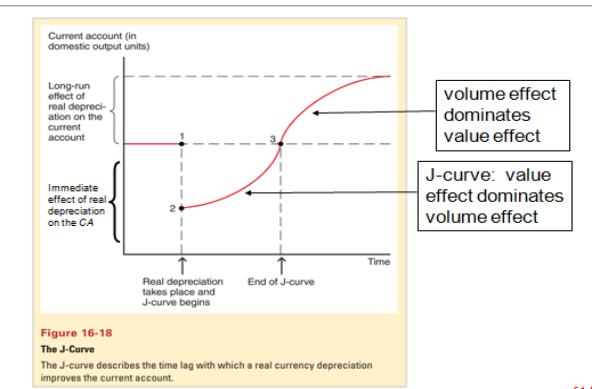
•The current account could immediately decrease after a currency depreciation, then increase gradually as the volume effect begins to dominate the value effect.
•Pass through from the exchange rate to import prices measures the percentage by which import prices rise when the domestic currency depreciates by 1%.
•In the DD-AA model, the pass through rate is 100%: import prices in domestic currency exactly match a depreciation of the domestic currency.
•In reality, pass through may be less than 100% due to price discrimination in different countries.
firms that set prices may decide not to match changes in the exchange rate with changes in prices of foreign products denominated in domestic currency.
•If prices of foreign products in domestic currency do not change much because of a pass through rate less than 100%, then the
value of imports will not rise much after a domestic currency depreciation, and the current account will not fall much, making the J-curve effect smaller.
volume of imports and exports will not adjust much over time since domestic currency prices do not change much.
•Pass through less than 100% dampens the effect of depreciation or appreciation on the current account.
IS-LM Model
•In the DD-AA model, we assumed that investment expenditure is exogenous.
•In reality, the amount of investment expenditure depends on the interest rate.
investment projects often use borrowed funds, and the interest rate is the cost of borrowing.
a higher interest rate means less investment expenditure.
•In the IS-LM model says that investment expenditure is inversely related to the interest rate.
•The IS-LM model also allows for consumption expenditure and expenditure on imports to depend on the interest rate.
A higher interest rate makes saving more attractive and consumption less attractive.
However, the effect of the interest rate is much larger on investment than it is on consumption and imports.
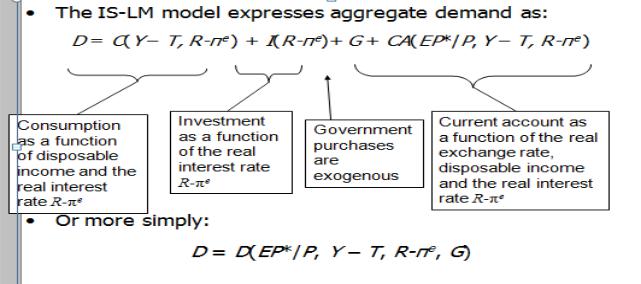
• Instead |
of |
relating |
exchange |
rates |
and |
output, |
the |
IS-LM relates interest rates and output.
•In equilibrium, aggregate output = aggregate demand
Y = D(EP*/P, Y – T, R-πe, G)
•In equilibrium, interest parity holds
R = R* + (Ee-E)/E
E(1+R) = ER* + Ee
E(1+R–R*) = Ee
E = Ee/(1+R–R*)
•Y = D(EeP*/P(1+R–R*) , Y – T, R-πe, G)
This equation describes the IS curve: combinations of interest rates and output such that aggregate demand equals output, given values of exogenous variables Ee,P*,P, R*,T, πe, and G.
Lower interest rates increase investment demand (and consumption and import demand), leading to higher aggregate demand and higher output in equilibrium.
The IS curve slopes down.
•In equilibrium, real money supply equals real money demand: Ms/P =
L(R,Y)
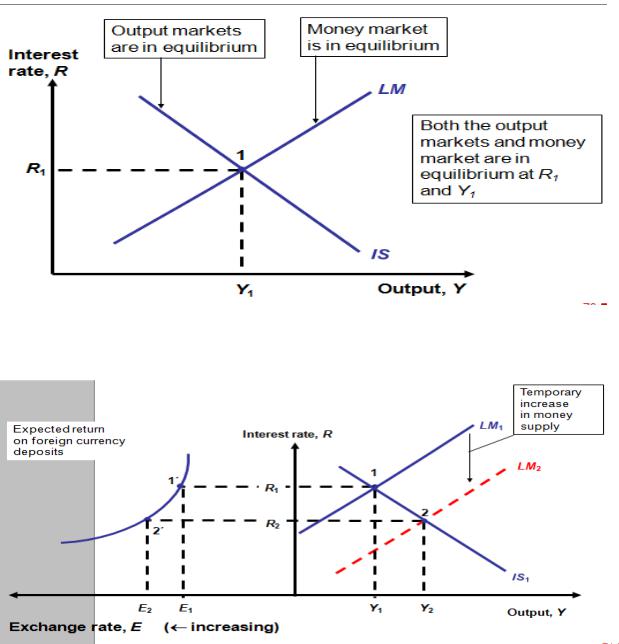
This equation describes the LM curve: combinations of interest rates and output such that the money market is in equilibrium, given values of exogenous values P and Ms.
Higher income leads to higher real money demand and higher interest rates in the money market.
The LM curve slopes up.
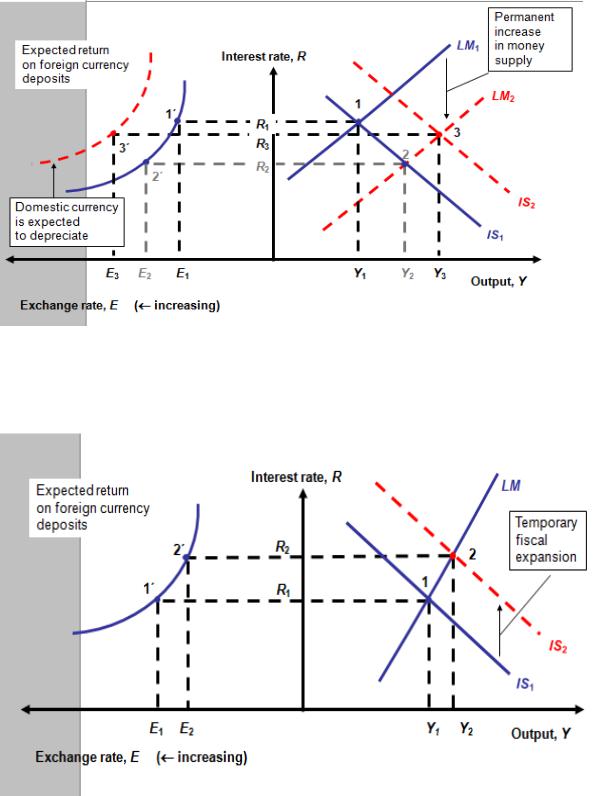
Effects of Permanent Changes in the Money Supply in the Short Run
Effects of Temporary Changes in Fiscal Policy
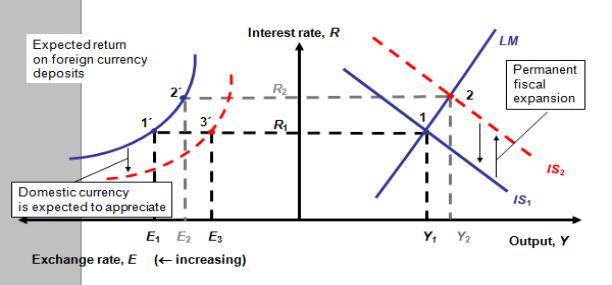
Effects of Permanent Changes in Fiscal Policy
Summary
1.Aggregate demand is influence by disposable income and the real exchange rate.
2.The DD curve shows combinations of exchange rates and output where aggregate demand = output.
3.The AA curve shows combinations of exchange rates and output where the foreign exchange market and money market are in equilibrium.
4.In the DD-AA model, we assume that a depreciation of the domestic currency leads to an increase in the current account and aggregate demand.
5.But reality is more complicated, and the J-curve shows that the value effect at first dominates the volume effect.
6.A temporary increase in the money supply increases output and depreciates the domestic currency.
7.A permanent increase does both to a larger magnitude in the short run, but in the long run output returns to its normal level.
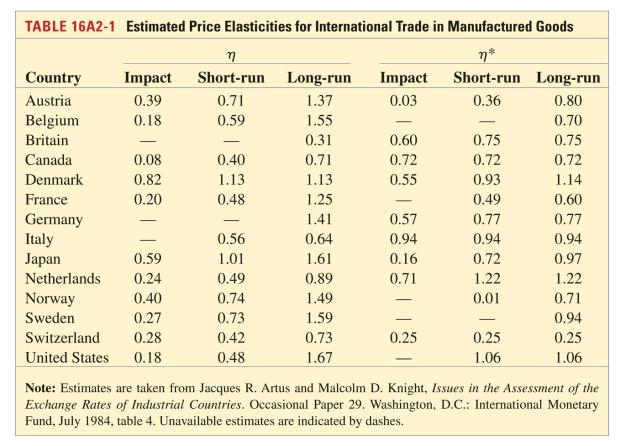
8.A temporary increase in government purchases increases output and appreciates the domestic currency.
9.A permanent increase in government purchases completely crowds out net exports, and therefore has no effect on output.
10.The IS-LM model compares interest rates with output.
11.The IS curve shows combinations of interest rates and output where aggregate demand = output.
12.The LM curve shows combinations of interest rates and output where the money market is in equilibrium.
13.The IS-LM model can be used with the model of the foreign exchange market to compare output, interest rates and exchange rates.
Trade Elasticities
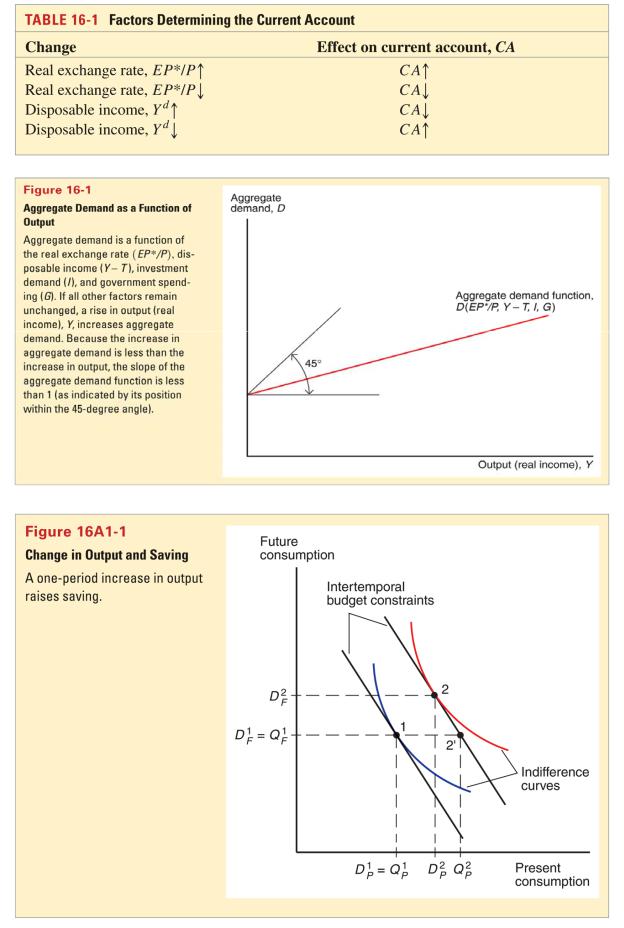
Chapter 17
Fixed Exchange Rates and Foreign Exchange Intervention
Preview
•Balance sheets of central banks
•Intervention in the foreign exchange market and the money supply
•How the central bank fixes the exchange rate
•Monetary and fiscal policies under fixed exchange rates
•Financial market crises and capital flight
•Types of fixed exchange rates: reserve currency and gold standard systems
•Zero interest rates, deflation and liquidity traps
Introduction
•Many countries try to fix or “peg” their exchange rate to a currency or group of currencies by intervening in the foreign exchange market.
•Many with a flexible or “floating” exchange rate in fact practice a managed floating exchange rate.
The central bank “manages” the exchange rate from time to time by buying and selling currency and assets, especially in periods of exchange rate volatility.
•How do central banks intervene in the foreign exchange market?
Central Bank Intervention and the Money Supply
•To study the effects of central bank intervention in the foreign exchange market, first construct a simplified balance sheet for the central bank.
This records the assets and liabilities of a central bank.
